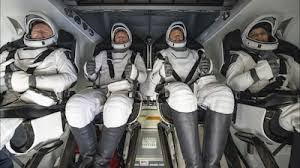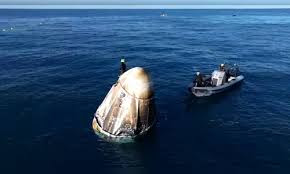Sunita Williams's Unforgettable Journey Back to Earth
On March 19, 2025, NASA astronauts Sunita Williams and Butch Wilmore returned to Earth after a nine-month mission aboard the International Space Station (ISS). Their journey was supposed to be a routine eight-day test flight of Boeing's Starliner spacecraft, but it turned into a much longer and more challenging experience.
The Challenges
Williams and Wilmore launched on June 5, 2024, as part of the first crewed flight of the Starliner. However, shortly after they arrived at the ISS, engineers discovered several critical issues with the spacecraft, including helium leaks and propulsion system malfunctions. These problems rendered the Starliner unsafe for their return journey, stranding Williams and Wilmore on the ISS.
A Long Wait
NASA made the decision to send the Starliner back to Earth uncrewed to free up docking space for other missions, leaving Williams and Wilmore to wait for a safe return plan. They remained on the ISS for nearly nine months, becoming part of NASA's Crew-9 rotation.
A Safe Return
Finally, on March 19, 2025, Williams and Wilmore were able to return to Earth on a SpaceX Crew Dragon spacecraft. They landed safely off the coast of Florida, ending their long and unexpected mission.
The Impact
Williams and Wilmore's experience has had a significant impact on the future of space travel. The failure of Boeing's Starliner has raised concerns about the safety of commercial spaceflight, and it has also highlighted the importance of having multiple options for returning astronauts to Earth.
A New Era of Space Travel
Despite the challenges, Williams and Wilmore's mission is a testament to the resilience and determination of astronauts. It also marks a new era of space travel, one in which commercial companies are playing an increasingly important role.
Sunita Williams and Butch Wilmore's journey back to Earth was a long and challenging one, but it was also a successful one. Their safe return is a reminder of the importance of perseverance and teamwork in the face of adversity.
Additional Information
• Sunita Williams is a former NASA astronaut who has spent more than 322 days in
space. She is the first Indian-American woman to travel to space.
• Butch Wilmore is a former NASA astronaut who has spent more than 177 days in
space. He is a retired U.S. Navy captain.
• The International Space Station is a large spacecraft that orbits the Earth. It is used for
scientific research and other purposes.
• Boeing's Starliner is a spacecraft that is designed to carry astronauts to and from the
International Space Station.
• SpaceX's Crew Dragon is a spacecraft that is also designed to carry astronauts to and
from the International Space Station.
Sunita Williams's Unforgettable Journey Back to Earth: A Deeper Dive
The Initial Promise and the Abrupt Reality
The Boeing Starliner's Crew Flight Test (CFT) was meant to be a pivotal moment, a demonstration of the spacecraft's readiness to ferry astronauts to and from the International Space Station (ISS). Sunita Williams, a seasoned astronaut with a wealth of spaceflight experience, and Butch Wilmore, a veteran test pilot, were chosen for this critical mission. Their selection underscored the importance of the test, as their expertise would be crucial in evaluating the Starliner's performance.
The launch, initially delayed due to various technical checks, finally occurred on June 5, 2024. The anticipation was palpable. However, within hours of reaching the ISS, the mission began to unravel. Helium leaks, a known issue with the Starliner's propulsion system, resurfaced, and unexpected thruster failures added to the growing list of anomalies.
The Helium Leak and Propulsion Challenges
Helium is crucial for pressurizing the Starliner's propulsion system, ensuring the thrusters fire correctly for orbital manoeuvres. The leaks, though initially deemed manageable, raised serious concerns about the spacecraft's long-term reliability. The propulsion system, essential for docking and undocking from the ISS, also experienced unexpected behaviour, with some thrusters failing to ignite as commanded.
NASA and Boeing engineers worked tirelessly to analyze the data and develop mitigation strategies. However, the cumulative effect of these issues painted a picture of a spacecraft that was not yet ready for routine crewed operations. The decision to extend the mission, initially intended as a short stay, was made to allow engineers more time to assess the Starliner's condition and develop a safe return plan.
Life Aboard the ISS: A Prolonged Stay
For Williams and Wilmore, the extended stay aboard the ISS meant adapting to a prolonged mission. They continued their scheduled scientific experiments and maintenance tasks, contributing to the ongoing research on the orbiting laboratory. However, the uncertainty surrounding their return added a layer of complexity to their daily routines.
The ISS, a marvel of engineering, became their temporary home for an extended period. They worked alongside other crew members from different nations, fostering international collaboration and scientific progress. Yet, the knowledge that their return was contingent on resolving the Starliner's issues weighed heavily on their minds.
The Decision to Utilize SpaceX Crew Dragon
As the weeks turned into months, NASA and Boeing faced the reality that the Starliner's issues could not be resolved quickly. The decision was made to prioritize the safety of the astronauts and utilize the SpaceX Crew Dragon spacecraft for their return. This decision, though practical, highlighted the complexities of commercial spaceflight and the importance of having alternative transportation options.
The SpaceX Crew Dragon, a proven and reliable spacecraft, had successfully transported numerous astronauts to and from the ISS. Its availability provided a crucial safety net for Williams and Wilmore.
The Return and the Aftermath
On March 19, 2025, Williams and Wilmore boarded the SpaceX Crew Dragon, undocked from the ISS, and began their journey back to Earth. The landing, a splashdown off the coast of Florida, was a moment of relief and celebration.
The aftermath of the Starliner's CFT failure prompted a thorough review of the spacecraft's design, manufacturing, and testing processes. Boeing and NASA committed to addressing the identified issues, ensuring the Starliner's future missions would be conducted safely and reliably.
The incident also underscored the importance of rigorous testing and validation for commercial spaceflight systems. The challenges faced by the Starliner highlighted the complexities of space travel and the need for continuous improvement in spacecraft technology.
The Broader Implications for Commercial Spaceflight
The Starliner's challenges have broader implications for the commercial spaceflight industry. While companies like SpaceX have demonstrated the viability of private space transportation Starliner's experience serves as a reminder that spaceflight remains a complex and challenging endeavour.
The incident has likely led to increased scrutiny of commercial spacecraft development and testing, with a focus on ensuring the safety and reliability of these systems. It has also reinforced the importance of collaboration between government agencies and private companies in advancing space exploration.
Sunita Williams: A Symbol of Resilience
Throughout the ordeal, Sunita Williams remained a symbol of resilience and professionalism. Her calm demeanour and unwavering dedication to the mission inspired her colleagues and the public alike. Her experience, coupled with Butch Wilmore’s, provides valuable data for future missions.
Her ability to adapt to unexpected circumstances and maintain a positive attitude in the face of adversity is a testament to her character and training. Her experience will undoubtedly contribute to the ongoing evolution of spaceflight and the development of safer and more reliable spacecraft.
Future Considerations and Lessons Learned
The Starliner's extended stay and the eventual use of the Crew Dragon for return highlight the need for robust contingency plans in space missions. Future designs may incorporate more redundancy in critical systems, and mission protocols may be adjusted to allow for more flexible responses to unforeseen events.
The incident also underscores the importance of continuous monitoring and analysis of spacecraft performance, even after successful launches. The ability to detect and address potential issues early on is crucial for ensuring the safety of astronauts and the success of missions.
Sunita Williams and Butch Wilmore's journey, though fraught with unexpected challenges, ultimately culminated in a safe return. Their experience has provided valuable lessons for the spaceflight community, contributing to the ongoing effort to make space travel safer and more accessible.



